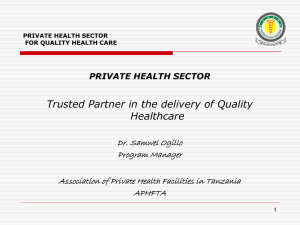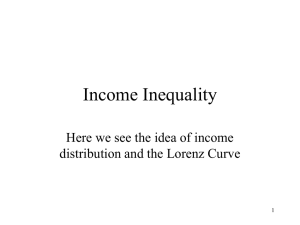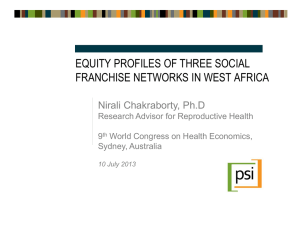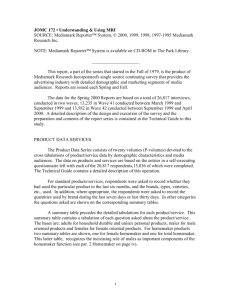Beyond volume: Does hospital complexity matter? An analysis of
advertisement
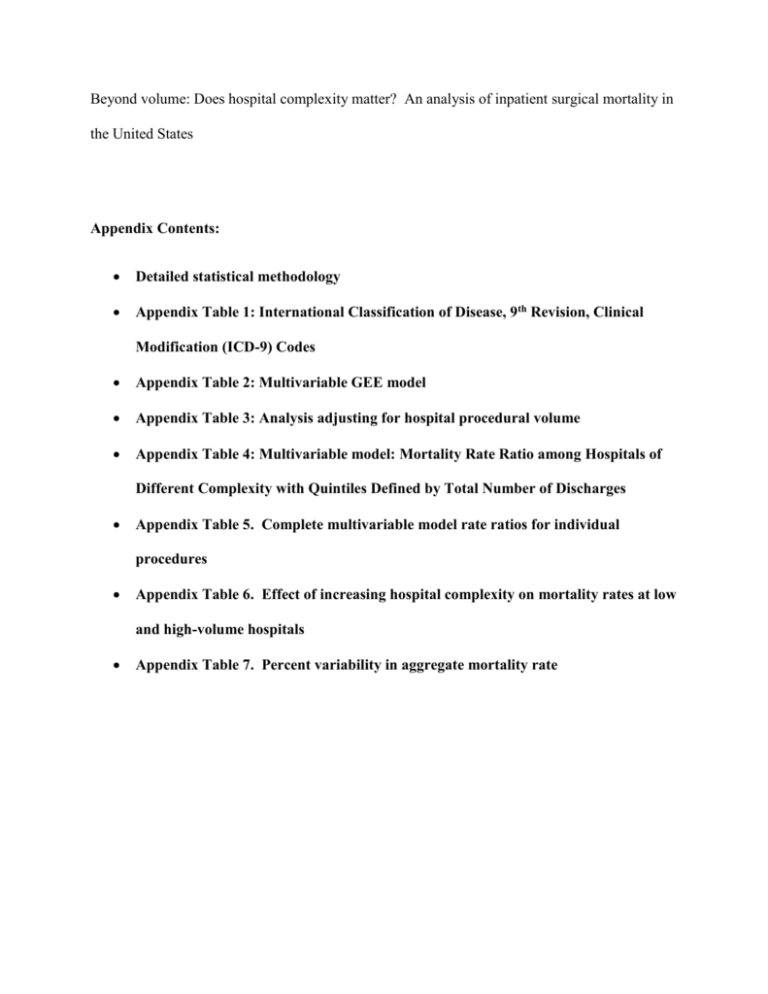
Beyond volume: Does hospital complexity matter? An analysis of inpatient surgical mortality in the United States Appendix Contents: Detailed statistical methodology Appendix Table 1: International Classification of Disease, 9th Revision, Clinical Modification (ICD-9) Codes Appendix Table 2: Multivariable GEE model Appendix Table 3: Analysis adjusting for hospital procedural volume Appendix Table 4: Multivariable model: Mortality Rate Ratio among Hospitals of Different Complexity with Quintiles Defined by Total Number of Discharges Appendix Table 5. Complete multivariable model rate ratios for individual procedures Appendix Table 6. Effect of increasing hospital complexity on mortality rates at low and high-volume hospitals Appendix Table 7. Percent variability in aggregate mortality rate Detailed Statistical Methodology Indirect Standardization: To generate the indirectly-standardized mortality rate, we first calculated each hospital’s ratio of observed to expected deaths. The numerator of the ratio is the sum of the actual deaths for each procedure at that hospital, and the denominator is the sum of the individual risk probabilities generated by the patient-level logistic regression model for each procedure (the “expected” deaths). This ratio is also referred to as the “Standardized Mortality Ratio”. To get the indirectly standardized mortality rate, we then multiplied this ratio by the crude (unadjusted) population mortality rate (total number of deaths divided by the total number of admissions for the procedures included in the composite). Using this method, procedures that are performed more frequently in one hospital contribute more data to that hospital’s indirect standardized mortality rate than a procedure for which the hospital might have only a small number of cases. In this way, the indirect standardization model accounts for differences in volume of each condition across hospitals. Partial-R2: The total R-square is the proportion of variation in the outcome jointly explained by all variables in the model. The partial R-square is the proportion of variation explained by one variable when all others are included in the model. If all covariates were uncorrelated, then the partial R-squares would add up to the total R-squares. However since the variables are correlated, when looking at one covariate after adjusting for all other variables, the other variables will be explaining some of the effect of that covariate, so the sum of the partial R-squares will have to be less than the total R-square. Appendix Table 1: International Classification of Disease, 9th Revision, Clinical Modification (ICD-9) Codes Procedure ICD-9 Procedure Code Coronary artery bypass graft 3610 – 3617, 3619 Abdominal aortic aneurysm repair 3864, 3834, 3844 Above knee amputation 8417 Colon resection 1731-1736, 1739, 4503, 4526, 4541, 4549, 4552, 4549, 4571-4576, 4579, 4581-4583 Small bowel resection 4531, 4532, 4533, 4534, 4551, 4561, 4562, 4563, 4591, 4602 Appendix Table 2: Multivariable model Estimate 95% Confidence Interval p-value Lowest complexity quintile 0.23 0.15 – 0.32 <0.001 Quintile 2 0.19 0.14 – 0.25 <0.001 Quintile 3 0.09 0.04 – 0.14 <0.001 Quintile 4 0.03 -0.02 – 0.07 0.25 -0.04 -0.05 – -0.02 <0.001 -0.10 -0.21 – 0.02 0.10 -0.04 -0.09 – -0.003 0.03 South 0.05 0.02 – 0.09 0.01 West -0.04 -0.09 – 0.01 0.14 0.01 -0.03 – 0.06 0.56 -0.01 -0.05 – 0.04 0.78 Complexity Highest complexity quintile Number of discharges reference (5,000 discharge increment) Urban Geographic Region Northeast Midwest reference Ownership Investor-owned Government-owned Non-profit reference Teaching status -0.03 -0.07 – 0.02 0.22 Percentage Medicare 0.007 -0.002 – 0.02 0.14 0.02 0.01 – 0.02 <0.001 -0.01 0.01 – 0.02 <0.001 (5% increment) Disproportionate share index (5% increment) County Household Income ($10,000 increment) Appendix Table 3: Analysis adjusting for hospital procedural volume 30-day Complete model rate Complete model rate ratio standardized ratio using hospital using procedural volume mortality rate, % discharges (95% CI) (95% CI) Lowest 12.3 complexity (11.5 – 13.1) Quintile 2 11.4 (10.9 – 11.9) Quintile 3 9.8 (9.5 – 10.1) Quintile 4 8.9 (8.7 – 9.2) Highest 8.1 complexity (7.9 – 8.2) 1.27 (1.17 – 1.37) 1.25 (1.16 – 1.35) 1.22 (1.15 – 1.29) 1.20 (1.13 – 1.27) 1.10 (1.04 – 1.15) 1.08 (1.03 – 1.14) 1.03 (0.98 – 1.07) 1.02 (0.98– 1.06) 1.0 1.0 Appendix Table 4. Multivariable model: Mortality Rate Ratio among Hospitals of Different Complexity with Quintiles Defined by Total Number of Discharges Model 1 30-day Unadjusted Model standardized mortality rate, % Lowest complexity Rate Ratio Model 2 Model 3 Model 1 plus Model 2 plus Hospital and Hospital Population Volume*± (95% CI) Demographics* 1.43 (1.36 – 1.49) 1.37 (1.31 0 1.44) 1.25 (1.16 – 1.35) 1.24 (1.18 – 1.30) 1.20 (1.14 – 1.26) 1.11 (1.03 – 1.19) 1.15 (1.10 – 1.21) 1.12 (1.07 - 1.18) 1.05 (0.99 – 1.12) 1.07 (1.02 – 1.12) 1.06 (1.01 – 1.10) 1.01 (0.96 – 1.07) 1.0 1.0 1.0 11.5 (11.1 – 11.9) Quintile 2 9.4 (9.1 – 9.7) Quintile 3 8.7 (8.5 – 9.0) Quintile 4 8.1 (7.9 – 8.4) Highest complexity 7.6 (7.3 – 7.9) Abbreviations: CI, confidence interval *Adjusted for hospital region, urban location, ownership, teaching status, percentage of patients insured by Medicare, Disproportionate Share Index and median county household income ± Adjusted for total number of discharges 2008-2009 Appendix Table 5. Complete multivariable model rate ratios for individual procedures AAA Repair Above Knee Coronary Artery Colon Resection Small Bowel Resection Amputation Bypass Graft * 1.52 (1.12 – 2.07) * 1.04 (0.93 – 1.15) 0.90 (0.70 – 1.15) Quintile 2 * 1.16 (0.95 – 1.42) 1.28 (1.04 – 1.59) 1.02 (0.94 – 1.11) 1.02 (0.90 – 1.15) Quintile 3 1.28 (0.83 – 1.97) 1.15 (1.00 – 1.32) 1.06 (0.92 – 1.22) 1.00 (0.93 – 1.08) 1.02 (0.94 – 1.12) Quintile 4 1.09 (0.88 – 1.36) 1.13 (1.01 – 1.26) 1.06 (0.96 – 1.17) 0.97 (0.91 – 1.03) 1.01 (0.94 – 1.09) 1.0 1.0 1.0 1.0 Lowest complexity Highest complexity 1.0 Appendix Table 6. Effect of increasing hospital complexity on mortality rates at low and high-volume hospitals Complexity Quintile Low Volume Quintile 1 Quintile 2 Quintile 3 Quintile 4 Quintile 5 11.67 (11.04 – 11.01 (10.02 – 10.10 (9.09 – 10.20 (9.27 – 8.85 (8.52 – 12.30) 11.99) 11.12) 11.13) 9.19) 9.18 (4.57 – 8.43 (6.60 – 7.83 (7.29 – 8.24 (8.08 – 13.79) 10.26) 8.37) 8.41) High * Volume * insufficient data for high volume hospitals in lowest complexity quintile Appendix Table 7. Percent variability in aggregate mortality rate* Partial-R2 Hospital Complexity 3.72 Number of discharges 1.49 Urban location 0.16 Northeast region 0.27 South region 0.43 West region 0.13 Investor-owned 0.02 Government-owned 0.005 Teaching status 0.09 Percentage Medicare 0.13 Disproportionate Share Index 1.58 County Income 0.64 Complete Model Total R2 21.34 *Due to adjustment for interdependence of variables, the sum of the individual Partial-R2s will be less than the Total R2 for the entire model. See Appendix: Detailed Statistical Methodology for additional explanation.
